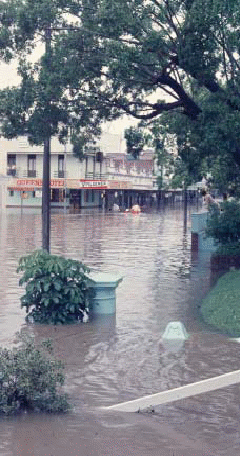 ropical
cyclones Projections are:
ropical
cyclones Projections are:Coastal Australia
An estimated 85 per cent of Australians now live within 50 kilometres of the coast
(ABS 2001b).
Concentrated in towns and cities along the coastal fringes of the east, south-east and south-west. Between 1991 and 1996, onequarter of Australia’s total increase in population was concentrated within three kilometres of the coastline – predominantly within the “sun-belt” locations on the New South Wales and Queensland coast and in the south-west of Western Australia.
This population growth means that the community’s exposure to extreme events — notably tropical cyclones, storm surges and flooding of rivers in deltas and other outflow regions — is growing rapidly. http://www.agfoodgroup.gov.au
Sea-level rise will have impacts on soft sediment shorelines and intertidal ecosystems, Low-lying coastal
terrain may become inundated, beaches eroded, coastal infrastructure damaged or destroyed, and people injured or killed. Warmer ocean waters and sediment transport following heavy rainfall will affect fisheries and coastal ecosystems. This in turn affects Queeensland's food supply and will cause mass evacuations.
It is generally accepted that the coastline will retreat horizontally 50 to 100 times the vertical sealevel rise. Hence, the predicted global sea-level rise would cause a coastal recession of sandy beaches of 4.5 to 88 metres by 2100.
T ropical
cyclones Projections are:
ropical
cyclones Projections are:
Maximum wind speeds may increase by 5–10% and precipitation rates may increase by 20–30%.
More intense tropical cyclones would have serious implications for storm surge heights, wind damage, flooding
and landslides on the steep escarpments of eastern Australia.
Coastal impacts
Communities and infrastructure
Coastal communities and urban infrastructure will be affected by changes in sea level and extreme weather.
Torrential rainfall over cities and surrounding catchments can produce severe runoff and flooding.
Damage to buildings is caused by both the depth of floodwaters and by the force of the water flow. Both contribute to structural fatigue. Gales and strong winds directly damage buildings and also generate waves and storm surges that can contribute to coastal flooding. More frequent high-intensity rain in some areas will also increase the risks of landslides and erosion, particularly in the urbanized catchments on Australia’s east coast.
For the past three decades, the total cost of floods has ranged between $2.5 billion and $4 billion per decade. It has been estimated that more than 80% of the buildings at risk from flooding are located within Queensland and New South Wales.
Flooding in Maryborough, Queensland
By 2050, sea level may rise 0.1 to 0.4 metres and tropical cyclone intensity around Cairns in northern Queensland could increase by up to 20%. Rising sea level, stronger tropical cyclones and increased intensity of associated storm surges are likely with climate change
This would increase the flood level associated with a 1-in-100 year flood in Cairns from the present height of 2.3 to 2.6 metres to 2.7 to 3.0 metres.
A4c_s1